Although aircraft noise cannot be completely eliminated, Edinburgh Airport works to understand and minimise community impact and are committed to explaining what you are hearing and why.
What is the Difference between Sound and Noise?
Sound is caused by the vibration of air particles. This creates waves of high and low pressure, which are picked up by the ear and processed by the brain. A sound becomes a noise when it causes an adverse effect on the listener. This is because the sound is unwanted and it starts to cause annoyance due to it being unpleasant, undesired, irrelevant or never-ending.
What causes a sound to become a noise depends on many factors, such as its character, frequency content, the duration of the sound and when the sound occurs and whether the sound was unexpected.
What is Aviation Noise?
Aviation noise is caused when aircraft taxi, fly, take-off and land. All aircraft produce some noise, however loud or quiet they are. The noise varies between aircraft types and even between aircraft of the same model. How this noise is received (by a person or microphone) at ground level will also vary. The noise from aircraft can be affected by many different factors, including temperature, humidity, engine size, loaded weight and wind speed.
Why do we Measure Noise?
Noise is considered a type of pollution which can create annoyance and health issues. Research is increasingly finding that aviation noise can lead to both stress and sleep disturbance, both of which can have negative impacts on health.
Health impacts from noise become noticeable when levels exceed a threshold known as the Lowest Observable Adverse Effect Level (LOAEL). Beyond this point, there’s a measurable increase in the risk of serious health issues such as hypertension, dementia, heart attacks, and strokes. Furthermore, exposure to certain noise levels can also hinder learning outcomes in students.
While the UK government has set the LOAEL at 51 dB for airspace changes, other countries and the World Health Organisation recommend stricter daytime and nighttime limits of 45 dB and 40 dB, respectively.
Measuring aviation noise enables airports, regulators and policymakers to understand both who is exposed and what the potential impact on the communities may be. It helps to inform policies for regulating noise. For regulation to be effective, it is necessary that noise recording and modelling is measured using sophisticated computer algorithms.
As part of their work, ICCAN examined the way noise is reported by the aviation industry, including the noise metrics that are used. Metrics are a way of quantifying the relationship between the measured sound and the typical human reaction e.g. annoyance. Noise metrics for aviation have been investigated for over 70 years and this has resulted in many different metrics.
What are the Causes of Aviation Noise?
All aircraft produce noise. The noise produced varies between aircraft types and even between aircraft of the same model. How this noise is received (by a person or microphone) at ground level will also vary.
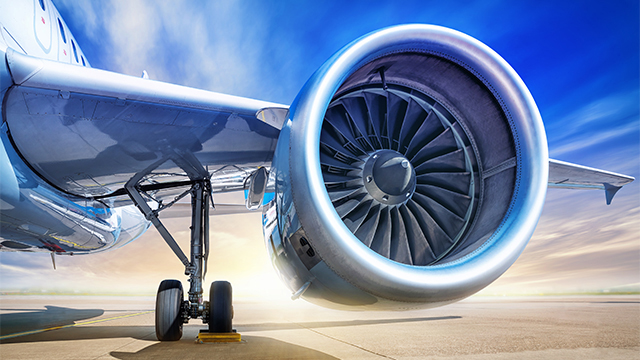
Engines
As you might expect, most aviation noise is caused by the engines. As well as moving parts making sounds, hot air is pushed out of the engine at a high speed, causing friction as it moves through the stiller, colder air around it.
Some modern bypass engines (engines with a large turbofan) are quieter than older aircraft engines because they interrupt the friction between the hot and cold air with a layer of cold air that moves at a medium speed.
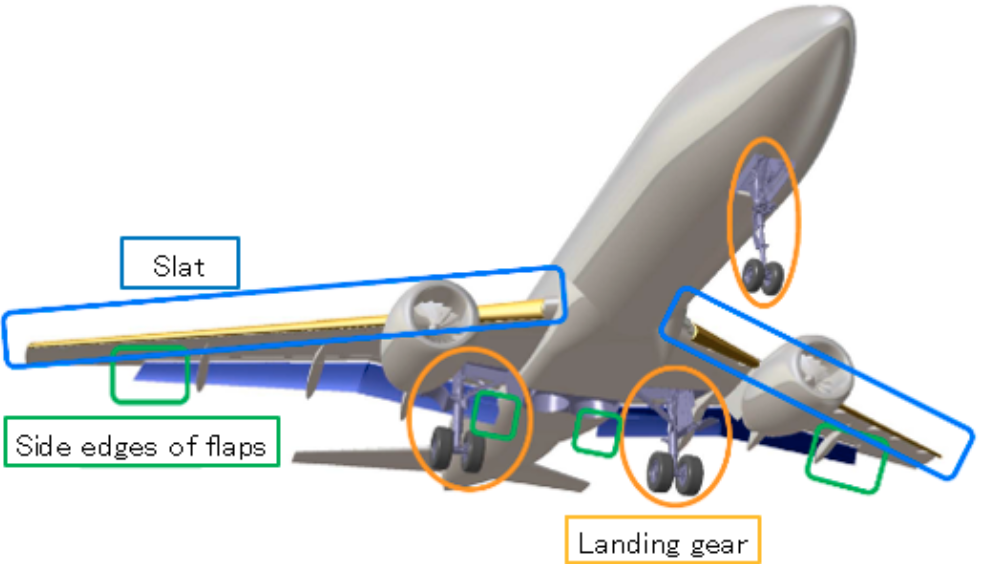
The Aircraft Body or Airframe
Even an aircraft without an engine, such as a glider, produces some noise. As an aircraft flies, its airframe causes friction and turbulence with the air. This produces sound waves. The faster an aircraft flies, the more friction it produces and more noise. When an aircraft uses its flaps (on the wings) and landing gear (wheels), there is increased surface area to create more friction which in turn generates more noise.
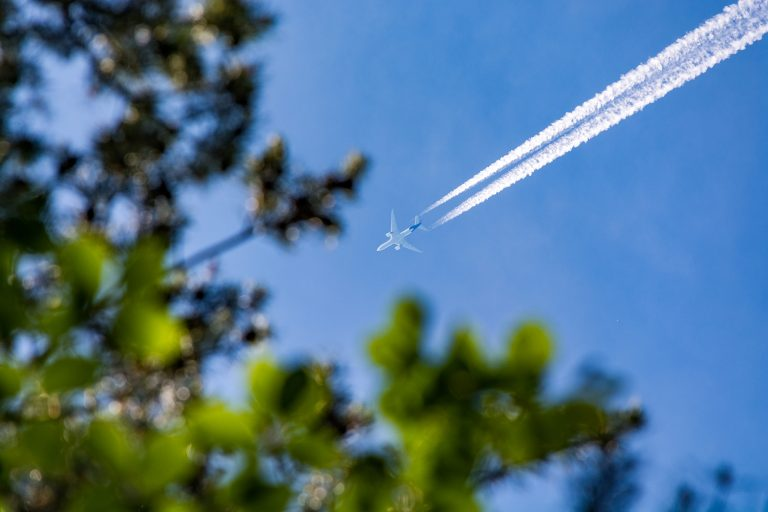
The Atmosphere
Temperature, humidity, rain, cloud and wind speed all affect the sound produced by an aircraft in flight and how we perceive the noise on the ground. Different types of weather can cause sound waves to echo, making aircraft seem louder. This echoing of sound can sometimes mean that aircraft can be heard from an altitude when they might normally be too high to hear.
Aircraft generally take-off into the wind, and land into the wind too, meaning that wind direction can change an aircraft’s flight path. A light breeze allows them to take off and land in the same direction, as it reduces the aircraft’s weight. Sometimes a stronger wind can cause an aircraft’s engines to work harder as it is necessary for it to push against the wind. For safety reasons heavy aircraft must depart and land in the same direction.
The Science of Sound
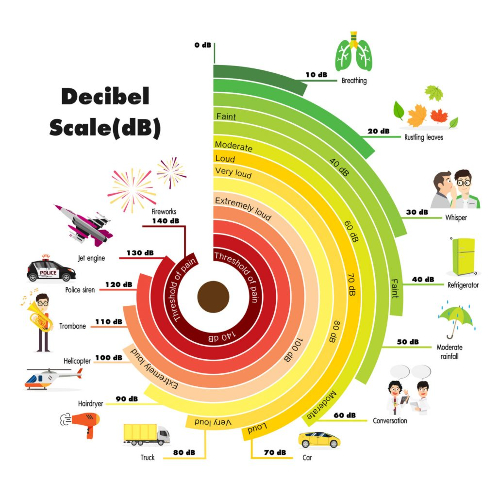
Understanding Measurements
Decibels (dB) are units used to measure the intensity or power of sound, reflecting how loud a noise is. They are measured on a logarithmic scale, where each increase of 10 dB represents a tenfold increase in sound intensity. This logarithmic scale aligns more closely with how humans perceive sound, although the relationship is not perfect due to complexities in the brain’s processing.
It’s important to note that even small increases in dB can mean a large increase in actual sound energy. For instance, a 3 dB increase doubles the sound energy. This can make it difficult to intuitively grasp how changes in dB levels translate to changes in perceived loudness.
While perceived noise plays a role in our experience, it’s the actual noise levels measured in dB that directly contribute to negative health impacts. This distinction is crucial when communicating information about noise and its effects on the public.
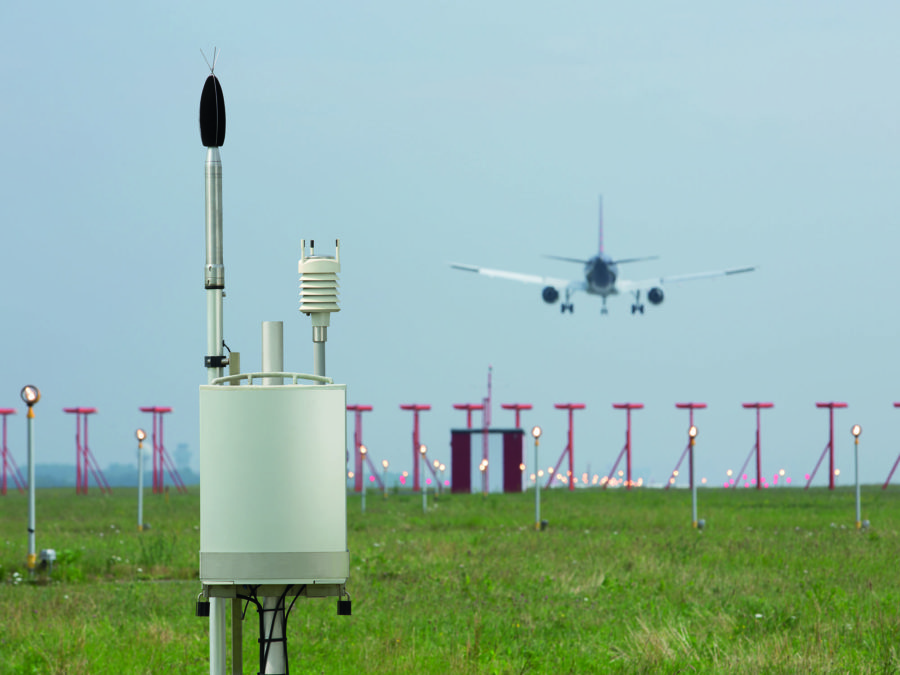
How do we Measure Noise?
Many airports measure sound using purpose-built sound level meters, often known as noise monitors. These consist of high-tech microphones that are designed to capture the sounds made by aircraft flying overhead. Noise monitors are high-precision instruments which are serviced regularly. They remain in one place for extended periods of time in order to collect lots of data, providing an overall reading of aviation noise.
There are handheld devices and even apps for mobile phones which measure sound. The noise monitors used by the aviation industry are much more accurate recorders of sound than the smaller hand-held devices or phones. This is for a number of reasons, including the way that microphones in phones are designed to reduce background noise. Positioning of the microphone during monitoring is also important to achieve reliable results.
The sound is measured to provide a description of a particular sound environment. This measurement can provide information not only about the level of the sound but also its characteristics (for example, how long and loud the sound is and how often it occurs). From the data captured, the effect of the sound is described by comparing it with established relationships for physiological and psychological responses, such as annoyance, for a typical human reaction. Decision-makers use this calculated noise impact to identify methods which can be implemented to lessen aviation noise at the source and reduce the impacts from noise.
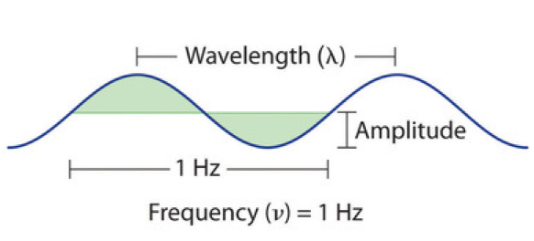
The Properties of Sound
Measurements of dB levels on their own do not sufficiently represent people’s experiences and perceptions of aircraft noise. This is because sound is made up of:
- the sound level, or amplitude (loudness)
- the frequency (pitch or tone of the noise)
- temporal aspects (a smooth noise like a hum or a more pulsating noise like a pneumatic drill)
Sound is made more complicated by human perception and the psychology of annoyance. For example, even if the dB level of an aircraft and another noise such as a washing machine were similar, the annoyance factor of the different sound events are likely to be perceived differently. This is because:
- You can control when to put the washing machine on
- You know what the washing machine sounds like
- You know when the washing machine will stop
These reasons are why “noise thermometers”, which try to match specific dB levels to everyday events, can be unhelpful or even misleading. Noise metrics have been developed to try and create a more representative way to quantify noise exposure as it would be experienced by a person.